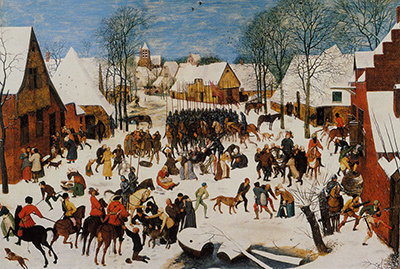Much like other contemporary artists of his era, Bruegel the Elder drew upon biblical imagery to utilise within his paintings.
Pieter Bruegel the Elder (c. 1525-1569) was a prolific Mediaeval painter and Massacre of the Innocents is considered to be one of his most popular (if not slightly disturbing) works.
Some scholars postulate that this work is a visual allegory to the slaughter of children in Bethlehem under the orders of King Herod.
What is interesting is that he was able to transpose such vivid imagery into his own time. This can be clearly witnessed in the distinctively Spanish and Germanic clothing worn by the mercenaries.
He also incorporated the frigid winter of 1564-1565 within this context; clearly in an attempt to bridge ancient atrocities into his own time period.
The Use of Multiple Visual Narratives
Pieter Bruegel makes use of what is sometimes termed as a "multiple narrative" approach. In other words, there are numerous actions occurring simultaneously.
This causes the viewer to experience a slightly overwhelmed sensation; perhaps exactly what he wanted to achieve. Different images require individual interpretations.
A father attempting to smuggle a child to safety, an incoming group of mounted soldiers and a woman grieving over a dead infant all evoke a sense of disorder and chaos.
Thus, the viewer is forced to take each situation in stride and it is only after a closer examination that he or she will be able to appreciate the painting in its entirety.
Unlike other works of Bruegel such as Peasant Wedding or Children's Games, Massacre of the Innocents employs the use of stark colours against a bleak and barren background.
However, we are left to wonder how the painting appeared in its original form. Many images such as slaughtered babies and pools of blood were covered in later years.




